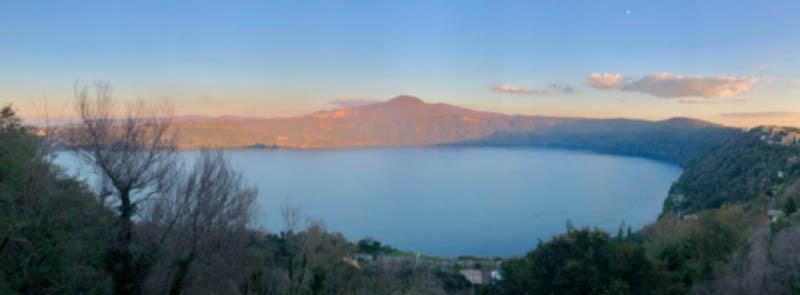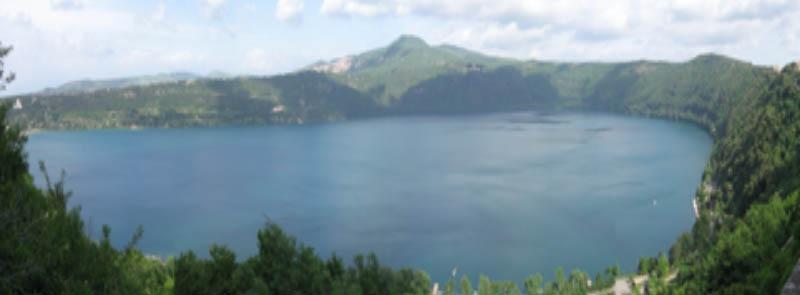Study site Lake Albano
Lake Albano is a closed crater basin located on the west side of the Colli Albani volcano in Latium (central Italy), nestled between small hills and a few municipalities of the area known as Castelli Romani, 25 km south-east of the city of Rome. On its coasts there are important prehistoric and Roman archaeological remains, such as the Village of Macine, the artificial emissary and the Doric and Bergantino nymphaeums, along with a part of the complex of the Villa Albana of Domitian.
The lake is located at 293 m above sea level and has an area of 5.2 km2, a perimeter of 10 km and a depth of ~ 175 m. Unlike most volcanic lakes, Albano is elliptical in shape, stretched in the NW-SE direction, filling two craters that represent the last known eruptive products of the volcano. For the frequent seismic activity in the volcanic system, the local uplift, the gaseous emissions (mostly CO2, H2S, HF) and the hydrothermal activity the area is still deemed geologically hazardous.
According to a hydrogeological study (Capelli et al. 2000), the lake is fed mainly by groundwater as it intercepts water from two aquifer systems, a regional one and a perched one.
Since 1960s the lake water level has dramatically lowered by more than 4 meters, mainly due to ongoing anthropogenic processes such as urbanization and over-exploitation of lake water and groundwater, that is not balanced by the meteoric intake, which has also decreased.
In addition, a 47 years-water renewal time combined with increase pollutants, mainly from sewage effluents and to a lesser extent from surface run-off, results in elevated levels of nitrogen and phosphorus that affect the water quality and increase the anthropogenic lake eutrophication.
Massive algal blooms are a well-known consequence of the excess of nutrient loading and storage to water bodies with low hydro dynamism, and lake Albano is also affected by algal blooms.
Following the large toxic algal bloom detected in February 2001, indeed, a study carried out by Istituto Superiore di Sanità (2001-2003) showed the presence of two steady populations of the toxic Cyanophycea Planktothrix rubescens. The toxins from these cyanobacteria, when produced in sufficient quantities can cause death of animals and pose risk to human health.
The high Nitrogenous/Phosporous ratio presents in Lake Albano is particularly favourable to algal bloom of the toxic P. rubescens.
For these reasons, bathing and lake fruition are in general forbidden to the population during the period of algal blooms (winter-early spring).
Sources
Capelli, G., R. Mazza, G. Giordano, D. De Rita & R. Salvati. 2000. The Colli Albano Volcano (Rome, Italy): equilibrium breakdown of a hydrological unit as a result of un-planned and undercontrolled over-exploitation. Hydro- géologie, 4: 63-70.
CHONDROGIANNI C., ARIZTEGUI D., GUILIZZONI P., LAMI A., 1996. Lakes Albano and Nemi (central Italy): an overview. In: P. GUILIZZONI, F. OLDFIELD (eds.), Palaeoenvironmental analysis of Italian crater lakes and Adriatic sediments (PALICLAS). Mem. Ist. It. Idrobiol., 55: 17–22.
Neil T.W. ELLWOOD, Patrizia ALBERTANO, Rosa GALVEZ, Renato FUNICIELLO and Rosario MOSELLO. Water chemistry and trophic evaluation of Lake Albano (Central Italy): a four year water monitoring study. J. Limnol., 68(2): 288-303, 2009 DOI: 10.3274/JL09-68-2-12
Sylvain Merel, David Walker, Ruth Chicana, Shane Snyder, Estelle Baurès, Olivier Thomas, State of knowledge and concerns on cyanobacterial blooms and cyanotoxins, Environment International, Volume 59, 2013, Pages 303-327, ISSN 0160-4120, https://doi.org/10.1016/j.envint.2013.06.013.
Istituto Superiore di Sanità Toxic algal species dynamic in the lakes of Albano and Nemi. Milena Bruno, Valentina Messineo, Daniela Mattei, Serena Melchiorre 2004, 55 p. Rapporti ISTISAN 04/32 (in Italian)
Lake Albano ( source Wikipedia https://commons.wikimedia.org/wiki/File:Lago_Albano_%E2%80%A2_Lake_Albano_(31863978677).jpg)
Panorama of Lago di Albano - picture taken just beneath Castel Gandolfo (source wikipedia https://commons.wikimedia.org/wiki/File:Panorama_Lago_Albano.jpg)












